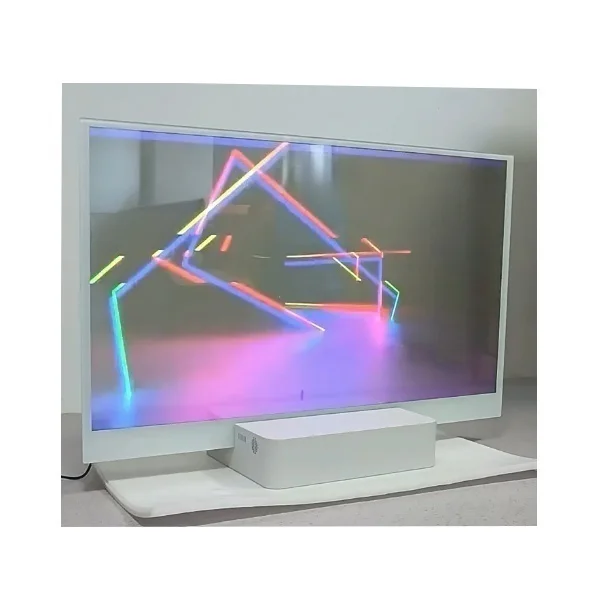The digital signage landscape is experiencing a revolutionary transformation with the emergence of transparent OLED displays. These cutting-edge screens represent a paradigm shift in how businesses communicate with their audiences, seamlessly blending digital content with physical environments. Unlike traditional displays that create barriers between viewers and the space behind them, transparent OLED displays offer an entirely new dimension of engagement while maintaining visual connectivity to the surrounding environment.

This innovative technology is rapidly gaining traction across multiple industries, from retail and hospitality to automotive and architectural applications. The ability to display vibrant content while maintaining transparency creates unprecedented opportunities for creative installations and functional applications that were previously impossible with conventional display technologies.
Understanding Transparent OLED Technology
The Science Behind Transparency
Transparent OLED displays operate on the principle of organic light-emitting diodes that can selectively emit light while allowing other wavelengths to pass through unobstructed. This technology eliminates the need for backlighting systems found in traditional LCD displays, which typically block light transmission. Instead, each individual pixel generates its own light, creating the possibility for true transparency when pixels are turned off.
The organic compounds used in these displays are deposited on transparent substrates, typically glass or flexible plastic materials. When an electric current is applied, these organic materials emit light at specific wavelengths, producing the desired colors. The transparency is achieved through careful engineering of the electrode layers and the organic materials themselves, ensuring optimal light transmission while maintaining excellent image quality.
Key Technical Specifications
Modern transparent OLED displays achieve transparency levels ranging from 40% to 85%, depending on the specific application and design requirements. The contrast ratios typically exceed 150,000:1, providing exceptional image clarity even in ambient lighting conditions. Resolution capabilities extend up to 4K and beyond, ensuring crisp, detailed content presentation that rivals traditional opaque displays.
Color gamut coverage often exceeds 90% of the DCI-P3 color space, delivering vibrant and accurate color reproduction. Response times are remarkably fast, typically under 0.1 milliseconds, making these displays suitable for dynamic content and interactive applications. Operating temperatures range from -20°C to +70°C, accommodating various environmental conditions across different installation scenarios.
Applications Across Industries
Retail and Commercial Environments
In retail settings, transparent OLED displays are transforming storefront presentations and in-store experiences. These screens can showcase product information, promotional content, and brand messaging while maintaining visibility of merchandise displayed behind them. Window installations create captivating displays that attract foot traffic while preserving the visual connection between interior and exterior spaces.
Shopping malls and department stores utilize these displays for wayfinding systems that don't obstruct sightlines or create visual barriers. The technology enables the creation of immersive environments where digital content enhances rather than replaces the physical shopping experience. Interactive capabilities further enhance customer engagement through touch-enabled transparent OLED displays that respond to gestures and proximity.
Architectural and Design Integration
Architects and interior designers are incorporating transparent OLED displays into building facades, partition walls, and decorative elements. These installations provide dynamic visual elements that can adapt to different times of day, events, or functional requirements while maintaining architectural integrity. The slim profile and lightweight construction make integration into existing structures feasible without significant structural modifications.
Smart building applications leverage these displays for information systems, emergency notifications, and environmental controls. The ability to display content selectively allows for privacy control and space optimization, where transparent modes enable open communication and opaque modes provide visual separation as needed.
Technical Advantages and Innovations
Superior Image Quality and Performance
The self-emissive nature of OLED technology eliminates issues commonly associated with LCD displays, such as backlight bleeding and limited viewing angles. Transparent OLED displays maintain consistent brightness and color accuracy across wide viewing angles, typically exceeding 160 degrees both horizontally and vertically. This characteristic makes them ideal for applications where viewers approach from multiple directions.
Power consumption is significantly lower compared to equivalent-sized LCD displays, particularly when displaying darker content or operating in partial transparency modes. The absence of backlighting systems and the ability to turn off individual pixels contribute to energy efficiency that aligns with sustainability goals in commercial and architectural applications.
Durability and Reliability
Advanced encapsulation techniques protect the organic materials from environmental factors such as moisture and oxygen, extending operational lifespans to over 30,000 hours of continuous operation. Anti-reflective coatings and scratch-resistant surfaces ensure long-term visual performance in high-traffic environments where traditional displays might suffer from wear and damage.
Thermal management systems integrated into the display design prevent overheating and maintain consistent performance across varying ambient conditions. These systems are particularly important in outdoor or semi-outdoor installations where temperature fluctuations could otherwise affect display longevity and image quality.
Installation and Integration Considerations
Mounting and Structural Requirements
The lightweight construction of transparent OLED displays simplifies installation compared to traditional signage solutions. Standard mounting systems can accommodate these displays with minimal structural reinforcement, reducing installation costs and complexity. Cable management systems are designed to maintain the aesthetic appeal of transparent installations while providing necessary power and data connections.
Ventilation requirements are minimal due to the efficient thermal characteristics of OLED technology, but proper airflow considerations ensure optimal performance and longevity. Installation guidelines specify clearance requirements and environmental parameters that maintain warranty coverage and expected operational lifespans.
Content Management and Control Systems
Modern transparent OLED displays integrate with existing digital signage networks through standard protocols and content management systems. Real-time content updates, scheduling capabilities, and remote monitoring ensure seamless operation across multiple installations. Advanced systems support synchronized content across arrays of displays, creating large-scale transparent video walls with pixel-perfect alignment.
Interactive capabilities require specialized software and sensor integration that maintains the transparency aesthetic while providing responsive user experiences. Touch detection systems can be embedded without significantly impacting transparency levels, enabling applications that respond to user interaction while preserving the see-through functionality.
Market Trends and Future Developments
Emerging Applications and Use Cases
The automotive industry is exploring transparent OLED displays for head-up display systems and passenger information displays that integrate seamlessly with vehicle interiors. These applications leverage the technology's ability to overlay digital information onto real-world views without obstructing driver visibility or passenger comfort.
Healthcare environments are beginning to adopt transparent OLED displays for patient monitoring systems and information displays that maintain visual connectivity between medical staff and patients. The technology enables discrete information presentation without creating barriers to communication or observation that are critical in medical settings.
Technological Advancement Trajectories
Research and development efforts focus on increasing transparency levels while maintaining brightness and color accuracy. Next-generation materials and manufacturing processes promise transparency levels approaching 95% with improved durability and reduced production costs. Flexible transparent OLED displays are emerging, enabling curved and shaped installations that conform to architectural elements and design requirements.
Integration with augmented reality systems and IoT networks represents the next evolution of transparent OLED displays, creating intelligent surfaces that respond to environmental conditions, user presence, and contextual information. These developments position transparent OLED technology as a fundamental component of smart environments and connected spaces.
FAQ
What is the typical lifespan of transparent OLED displays
Transparent OLED displays typically offer operational lifespans exceeding 30,000 hours of continuous use, with some models rated for up to 50,000 hours. The actual lifespan depends on usage patterns, environmental conditions, and content characteristics. Displays showing predominantly darker content or operating in partial transparency modes generally achieve longer lifespans due to reduced pixel stress and lower power consumption.
How do transparent OLED displays perform in bright ambient lighting conditions
Modern transparent OLED displays incorporate anti-reflective coatings and high-brightness capabilities that maintain visibility in ambient lighting conditions up to 50,000 lux. While direct sunlight can impact visibility, most indoor and semi-outdoor applications provide sufficient contrast and readability. Advanced models include ambient light sensors that automatically adjust brightness and contrast for optimal visibility across varying lighting conditions.
What are the power consumption characteristics compared to traditional displays
Transparent OLED displays typically consume 30-50% less power than equivalent LCD displays, particularly when displaying darker content or operating in transparency mode. The self-emissive nature eliminates the need for continuous backlighting, and individual pixel control allows for precise power management. Energy consumption varies based on content brightness and color saturation, with white content requiring maximum power and black content consuming virtually no energy.
Can transparent OLED displays be used in outdoor applications
While transparent OLED displays can function in semi-outdoor and covered outdoor environments, direct exposure to weather elements requires protective enclosures and environmental controls. Specialized outdoor-rated models incorporate enhanced sealing, thermal management, and anti-glare coatings suitable for exterior installations. Temperature ranges, humidity levels, and UV exposure must be carefully considered for outdoor applications to ensure optimal performance and longevity.

